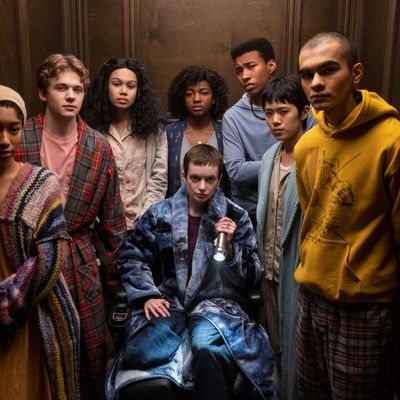
As we near the halfway point of The Midnight Club, we’re settling into a familiar groove with a pretty clear picture of what type of show this is. If you’ve seen Mike Flanagan’s previous series, particularly Midnight Mass, you may be familiar with this balance of drama and horror — with more screen time generally spent on the former.
If you’re hoping for a horror series that really gets under your skin — or even just a bingeable thriller that keeps you on the edge of your seat — you might be disappointed with this season so far. We haven’t yet seen anything here that approaches, say, Stranger Things levels of scary. The Midnight Club is more like a CW supernatural drama, but with a higher budget, featuring group-therapy scenes that wouldn’t feel out of place in The Fault in Our Stars. It relies primarily on the natural conflicts that develop among a group of terminally ill teens forming a tight-knit family in what’s likely the final year of their lives.
Part of me does get a little impatient when each episode only inches the plot forward in Ilonka’s solo detective mission (with Kevin sometimes there for an assist). In “Gimme a Kiss,” she finds the roster of the original Midnight Club, founded by none other than Julia Jayne. But the secret basement room predates Dr. Stanton’s purchase of Brightcliffe in the ’60s — with leftover cult supplies (robes, knife, etc.) left there for decades by the Paragon.
We learn a bit more about Shasta, who owns a naturopathic wellness company selling products with ingredients sourced from the forest around Brightcliffe. For now, she claims to know nothing about the Paragon, but she does suggest Ilonka check out the section of the library on alternative medicine, which leads her to a book with the hourglass symbol on its cover. Before we can learn the significance of the book, though, Ilonka and Kevin find Anya fallen over in her room, her fate left unknown.
Despite my slight impatience with the acceleration of The Midnight Club’s horror, I do love a teen drama, so I’m entertained enough following these characters on their journeys — especially because the show’s sense of humor and supernatural edge keep it from feeling too similar to other teen-cancer weepies. Anya, for one, is a character I care about, and the real cliffhanger of the episode comes from worrying about whether she’s fallen at the hands of the same shadow that followed Rachel in her final days. She has been foggy all episode, hoarding morphine and hearing strange whispers. It’s hard not to feel for her as she chants, “I’m still here” to herself, holding onto life no matter how impossible it might be.
I’m less interested in Kevin, though he gets a decent sub-subplot about going to Katherine’s prom and getting all the predictable reactions of melodramatic pity and condescending hero worship — even becoming prom king. But the main focal characters in “Gimme a Kiss” are Spence and Sandra, who are butting heads more than ever about Sandra’s faith.
It starts with her disapproval of a bunch of immunocompromised teens poking around in a moldy basement, especially one with weird sacrilegious cult-y shit. To deal with their grief over Tristan, she suggests, they should turn to faith. “Your faith cost me my community,” Spence tells her, furious over her self-righteousness. “Your god said I’m an abomination.”
What makes it all worse for Spence, of course, is that his meds aren’t working anymore. That doesn’t necessarily mean he’ll be gone within the month, as Mark sweetly assures him (I’m incapable of calling Mark anything but “sweet”), but it’s not good news. And if witnessing the supernatural is some indicator that you’re approaching the end point — as Anya and Rachel seeing the shadow might suggest — Spence hearing voices from the recovery room over the intercom is an even worse sign.
At the Midnight Club that night, Sandra apologizes to Spence by telling a story. Inspired by classic noir and presented to us in a nice black and white, most of the story is told by Alice Palmer (Sandra’s self-insert) to Detective Fisher (played by Dr. Stanton). Apparently, after Alice’s best friend and student journalist Jake (played by Spence) was exposed for having a secret relationship with Alice’s popular ex-boyfriend Kirk (played by Kevin), he swore to get revenge with the help of Sharon (played by Ilonka). Thinking Kirk and queen bee Patty (played by Natsuki) were involved, he planned to stoke their guilt by faking his own death at Alice’s boat party.
The plan worked — with Jake hiding underwater using Sharon’s scuba gear, then hiding out for the weekend at her parents’ cottage. But something went terribly wrong: Kirk jumped into the water to save Jake and ended up dead. This devastated Sharon, who’d always loved Kirk, so she killed Jake at the cottage, set it on fire, and fled.
Except, of course, this is all a fiction, as we learn when a very much alive Jake grabs Alice outside the police station and ties her up. In reality, Alice was the one who’d photocopied Jake’s journal and exposed him in the first place. Then she killed Kirk, killed Sharon, and torched the house. Jake survived, switched out the dental records to make himself appear dead, and identified Alice as the killer. And the reason she did all this? He gave her oral herpes. As Alice lies bleeding out on the floor, shot by Jake in self-defense and rescued by Sharon’s and Kirk’s angels, she apologizes. “Forget it, Jake,” she says, referencing Chinatown. “It’s murder town.”
As a self-contained story in its own right, Sandra’s tale is pretty rushed, cramming every major beat of a two-hour movie plot — or, say, a novel — into about 15 minutes. It becomes convoluted fast and never achieves any actual horror. But it’s a neat little tribute to film noir, and it demonstrates Sandra’s wish to push back against people’s expectations of her — given her characterization as “the Christian one.” Like Kevin imagining himself as a serial killer violating all the norms of a drearily average high-school existence, Sandra envisions herself as an almost femme fatale mastermind, manipulating and killing people behind the scenes only to go out with a dramatic ending monologue.
The herpes reveal may make for a (deliberately) clumsy ending to Sandra’s story — especially using an STD plot device in an apology to her gay friend with AIDS. But her regret is genuine when she tells Spence that God would never treat him the way that some of His supposed followers do. “You can’t love God and hate love,” she says, Annarah Cymone nicely conveying Sandra’s intense pain at the idea of her fellow Christians being so cruel. Spence gives her a kiss on the forehead — a touching and subtle end to their feud.
Stories like this one exist completely separate from the supernatural piece of the series; Spence is hearing voices, but otherwise his arc in this episode has nothing to do with the occult. Sometimes I long for a more skillful threading of horror throughout the interpersonal drama or a clearer understanding of how the ghosts of this place are interacting with our current crop of patients. But Spence and Sandra’s story line is enjoyable in its own right — with two friends working through their difference in beliefs and learning to see each other more complexly than they did before. That’s the power of storytelling.
Scary Stories
• There are no real romantic developments with any potential pairings yet, but Natsuki continues to flirt with Amesh, so stand by on that.
• Latest in dialogue that makes me think, Ehh, would a teen in the ’90s say this?: Ilonka saying, “That tracks.”


